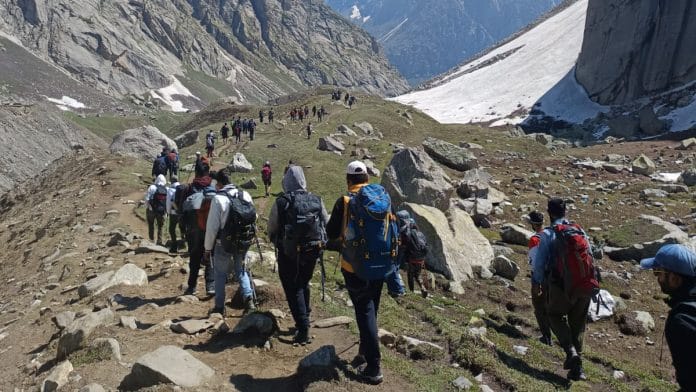The string of tragedies in the Uttarakhand mountains is a grim reminder of our collective failure to uphold safety standards that complement the growing popularity of high-risk outdoor activities. The repeated loss of life raises a critical and discomforting question: Why do we wait for catastrophic events before considering preventative measures, which too aren’t implemented in the long run?
In October 2021, the death of 12 trekkers on Lamkhaga Pass due to a lack of preparation and the severe weather conditions shook the outdoor community. A year later, an avalanche at Draupadi ka Danda-II claimed 29 lives during an advanced mountaineering course run by the Nehru Institute of Mountaineering (NIM).
The Sahastra Tal tragedy last month, in which nine people died, once again found trekkers unprepared for the harsh Himalayan weather. All these incidents are a clarion call demanding urgent action rather than a rhetorical commitment from Uttarakhand’s adventure sports management.
Accountability and the role of authorities
The primary onus of enforcing safety regulations unambiguously lies with the governing authorities. Uttarakhand’s Trekking Rules 2022 prescribed essential safety protocols like mandatory registration of operators, standardisation of safety equipment, and certifications for guides, among others.
This comprehensive framework is yet to be officially notified. Safety protocols in the state are often relegated to paperwork and invoked only after lives have been lost. This is precisely what the district administration of Uttarkashi is attempting as it drafts standard operating procedures and safety and regulatory guidelines for the district’s adventure industry.
It is high time authorities pivot from a reactive approach to a proactive safeguarding strategy. This includes rigorous regulation enforcement and regular audits. The government must also transform policy into practice, prioritising the lives of citizens over bureaucratic inertia and economic considerations.
Adventure operators must be made to adhere to safety norms while training participants for a trek. If they cut corners on essential safety measures for higher profit, they should face stringent penalties.
Also read: Sahastra Tal rescue operation was fastest in the state. And that isn’t enough
Self-regulation among trekkers
While authorities and tour operators are primarily responsible for safety during trekking expeditions, the trekkers too have a role to play. A substantial number of accidents in adventure sports arise from a lack of awareness among the participants.
Driven by the excitement of exploration, adventure enthusiasts often overlook the importance of adequate preparation and potential hazards, endangering not only themselves but also their fellow trekkers.
Recently, a precarious situation unfolded at Hampta Pass in Himachal Pradesh when over 100 inexperienced trekkers found themselves stranded. This group, drawn to the trek by enticing Instagram posts, had little understanding of the challenges involved. Late afternoon, as potential disaster loomed, the timely intervention of an experienced guide averted what could have been a massive tragedy.
This incident highlights a concerning trend: Untrained individuals are lured by social media into undertaking serious outdoor activities, risking their lives. There is a critical need for adventure enthusiasts to be fully aware of what trekking in the Himalayan ranges entails and be sufficiently prepared before the trek.
Trekkers must assess their fitness levels and readiness. They must learn about the terrain and weather conditions and engage actively with trek leaders, guides, and operators to understand the risks involved.
Participants should also enquire about emergency procedures, safety measures, and the professional qualifications of trek leaders and guides.
Also read: There’s a boom in senior citizens climbing the Himalayas. Risk evaluation is the first step
Collective action and regulation
Self-regulation among trekkers, of course, does not obviate the need for strong and enforceable regulatory frameworks. In 2018, the Adventure Tour Operators Association of India (ATOAI) had submitted a document titled ‘Adventure Tourism Guidelines‘ to the Ministry of Tourism.
Aimed at ensuring safety and sustainability for all participants, the guidelines detail comprehensive standards and procedures for land-based, air-based, and water-based adventure activities.
The document educates tour operators and other stakeholders about important safety equipment and lesser-known dangers.
When publishing these tourism guidelines, the Ministry of Tourism requested all state governments/UT administrations to adapt and promote them. The question is, was this done? One is also not sure if there has been a follow-up by the tourism ministry on this matter. Do these guidelines need to be legislated into a bill? Is it only then that they will be swiftly implemented?
As understood from ATOAI, it is working with the government on introducing a model law for adventure sports tourism in India. It also has urged every operator in the industry to follow the Seven Sigma process to eliminate all possibilities of failure. However, the machinery as always is sluggish and slow.
Enhancing safety in adventure sports requires a collaborative approach that includes government oversight, strict compliance by operators, and informed, responsible behaviour by participants. Public awareness initiatives can further promote the importance of safety measures.
A fundamental shift in how safety is perceived and implemented is necessary—from viewing it as a regulatory burden to embracing it as a cornerstone of outdoor adventure sports.
We must foster a culture where the thrill of adventure aligns with the imperatives of safety and preparedness, so the rugged beauty of the Indian Himalayas can be safely appreciated by everyone. The mountains invite us not just to explore, but to respect their might and the lives of those who dare to challenge them.
Anusha Subramanian is an independent journalist, mountaineer, and entrepreneur who has been writing specifically about adventure and mountaineering for over a decade. She posts under @sanushas. Views are personal.
(Edited by Prasanna Bachchhav)






